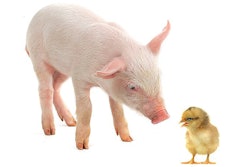
Greater feed efficiency may be achieved by applying the same treatments as cereals to soybeans
When it comes to discussing particle size of cereals in pig feeds, the discussion invariably sways to the question of soybeans. Should soybean meal be also finely ground, especially for young pigs? We know that the smaller the particle size of grinding in cereals, the better the feed conversion rate, so it may be reasonable to assume a similar response for soybeans.
While looking into this issue again very recently, it took me some time to uncover an older study by one of my favorite U.S. researchers, the late Donald Mahan of The Ohio State University. It was reported in 2003 and I still abide by it, although some newer reports (unpublished) have challenged these findings – even though they arrived at the same practical conclusions.
In brief, commercial soybean meal has a mean particle size of 900 to 1,200 microns as received from processing plants. Thus, soybean meal was ground through a hammer mill to 900, 600, 300, and 150 microns. Nutrient digestibility was then estimated in 14 barrows (28 kg and 60 days of age). Apparent and true ileal digestibility of isoleucine, methionine, phenylalanine and valine increased linearly with decreasing particle size. On average, apparent digestibility of essential amino acids increased from 83.5% to 84.9%, whereas true digestibility increased from 91% to 92.4%. Energy digestibility was not affected by particle size. The largest improvement in digestibility was observed when particle size was reduced to 600 microns.
As it appears, the improvement from grinding was rather small, and as such it is often counterproductive to grind soybean meal, unless it is received in a very coarse state.
















